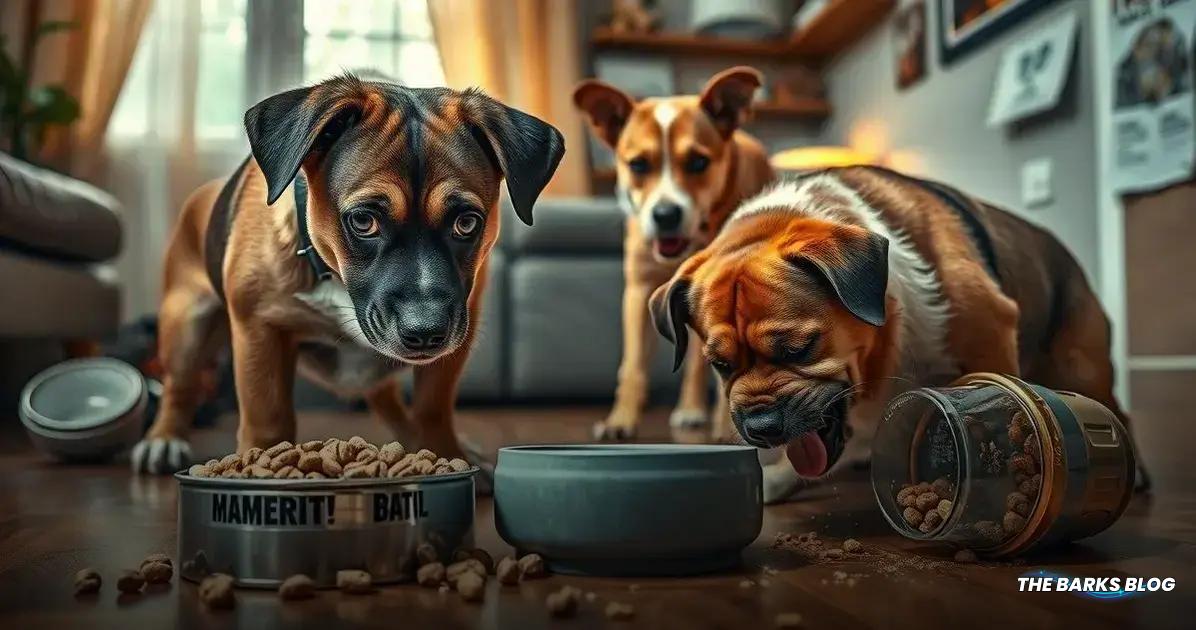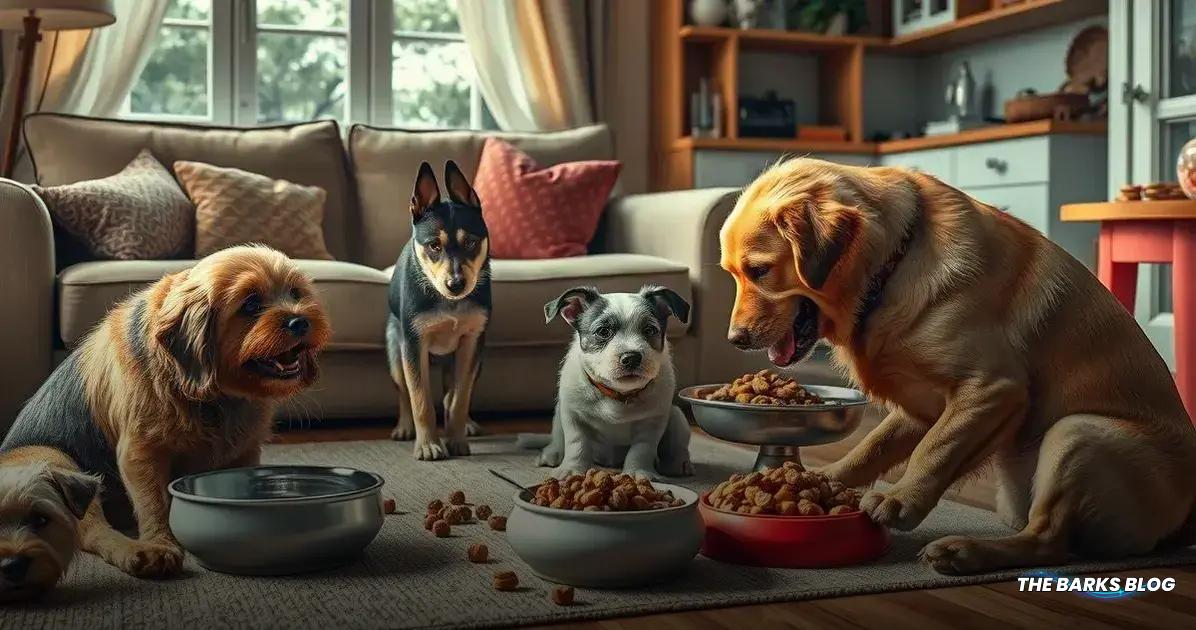Understanding dog eating disorders is essential for pet owners, as conditions like pica, overeating, under-eating, scoffing, and coprophagia can significantly impact a dog’s health. Factors such as stress, anxiety, and underlying health issues may contribute to these disorders. Key signs to watch for include changes in appetite, weight fluctuations, and behavioral shifts. Early intervention through consultation with a veterinarian is crucial for diagnosis and treatment, helping dogs establish a healthier relationship with food and ensuring their overall well-being.
In this blog, we ask, “Can dogs have eating disorders?” We learn what different types of eating disorders in dogs there are and how to spot each type of disordered eating in dogs.

Types of Dog Eating Disorders
When it comes to dog eating disorders, there are several types that pet owners should be aware of. Each disorder has its own characteristics and potential health implications. Here’s a closer look at the most common types:
Pica
Pica (pronounced Pie-Kuh) is a serious eating disorder where dogs consume non-digestible items. This can range from rocks and batteries to clothing and wires. Unlike a teething puppy that chews on things to relieve discomfort, dogs with pica are engaging in dangerous behavior that can lead to severe health issues, including damage to their gums, teeth, and internal organs. It’s crucial to address underlying causes, which may include psychological stress or serious medical conditions.
Overeating
Overeating is another common disorder that can often be managed by pet parents. Many dogs eat not out of hunger, but simply because food is available. This can lead to obesity, which poses risks such as joint problems and other serious health issues. It’s essential to monitor your dog’s food intake and consult with a veterinarian if you’re unsure about portion sizes.
Under-Eating
Doggy anorexia, or under-eating, can be a sign of serious health concerns. While skipping the occasional meal might not be alarming, consistently refusing food can indicate underlying issues that need veterinary attention. Causes can range from stress and anxiety to physical illnesses, making it important to act quickly if your dog is not eating.
Scoffing
Scoffing refers to when dogs eat their food too quickly, often appearing as if they’re vacuuming it up. This behavior can stem from competition for food with other pets or from past experiences as a puppy. If not addressed, scoffing can lead to digestive problems. Solutions include using special feeder bowls designed to slow down their eating.
Coprophagia (Feces Eating)
One of the more unpleasant eating disorders, coprophagia involves dogs eating feces, either their own or that of other animals. This behavior can expose dogs to parasites and bacteria, leading to health issues. If your dog is engaging in this behavior, it’s important to ensure they are on a reliable parasitic prevention plan and to consult with a vet for additional strategies.
Recognizing these types of eating disorders is the first step in ensuring your dog’s health and well-being. If you notice any of these behaviors, it’s essential to consult with your veterinarian to determine the best course of action.

Causes of Dog Eating Disorders
Understanding the causes of dog eating disorders is crucial for pet owners who want to ensure their furry friends maintain a healthy relationship with food. Here are several factors that can contribute to disordered eating behaviors in dogs:
Stress: Just like humans, dogs can experience stress, which may lead to changes in their eating habits. Stressors can include changes in the household, loud noises, or the presence of unfamiliar people or animals.
Anxiety: Anxiety can manifest in various ways, including eating disorders. Dogs may refuse to eat or overeat as a coping mechanism for anxiety caused by separation, fear of abandonment, or other emotional triggers.
Lack of Exercise: Dogs need regular physical activity to maintain their mental and physical health. A lack of exercise can lead to boredom, which may result in overeating or other disordered eating behaviors.
Lack of Mental Stimulation: Dogs are intelligent creatures that require mental engagement. Boredom from insufficient mental stimulation can lead to destructive behaviors, including eating disorders.
Curiosity: Dogs are naturally curious animals. Sometimes, this curiosity can lead them to consume non-food items, resulting in pica or other eating disorders.
Depression: Dogs can suffer from depression due to various factors, such as abuse, neglect, grief, or separation anxiety. This emotional state can lead to changes in appetite, including under-eating or overeating.
Underlying Health Conditions: Certain health issues, such as diabetes, hormonal imbalances, or gastrointestinal problems, can affect a dog’s appetite and eating habits. It’s essential to rule out these conditions with a veterinarian if you notice any concerning behaviors.
If you suspect your dog is experiencing an eating disorder, identifying the underlying cause is essential. Consulting with a veterinarian can help determine the best approach to address the issue and improve your dog’s overall well-being.

How to Identify Eating Disorders in Dogs
Identifying eating disorders in dogs can be challenging, especially since dogs can’t communicate their feelings directly. However, there are several signs and behaviors that pet owners can watch for to determine if their dog may be struggling with an eating disorder:
Changes in Appetite: Noticeable changes in your dog’s eating habits, such as refusing food, eating less than usual, or suddenly eating excessively, can be indicators of an eating disorder.
Weight Fluctuations: Monitoring your dog’s weight is essential. Significant weight loss or gain can signal underlying health issues or eating disorders. Keep an eye on their body condition and consult your vet if you notice drastic changes.
Behavioral Changes: Changes in behavior, such as increased anxiety, lethargy, or aggression around food, can indicate an eating disorder. If your dog becomes possessive of their food or shows signs of distress during mealtime, it’s time to investigate further.
Eating Non-Food Items: If your dog is consuming non-digestible items, such as rocks, plastic, or clothing, this behavior—known as pica—should be addressed immediately, as it can lead to severe health complications.
Vomiting or Diarrhea: Frequent vomiting or diarrhea after eating can indicate a serious issue. If your dog is experiencing gastrointestinal distress, it may be a sign of an eating disorder or another health problem that needs veterinary attention.
Rapid Eating: Dogs that eat their food too quickly, often referred to as scoffing, may be at risk of choking or digestive problems. This behavior can be a learned response from competition during puppyhood or from anxiety.
Feces Eating: If your dog is eating feces (their own or others’), this behavior—known as coprophagia—can be a sign of nutritional deficiencies, stress, or other health concerns.
If you observe any of these signs in your dog, it’s crucial to consult with a veterinarian. They can help determine the underlying causes of the eating disorder and recommend appropriate treatment options to ensure your dog’s health and happiness.
Conclusion
Recognizing and addressing eating disorders in dogs is essential for their overall health and well-being. Whether your dog is struggling with pica, overeating, under-eating, or any other disordered eating behavior, early identification and intervention can make a significant difference.
By understanding the various types of eating disorders, their causes, and how to identify them, pet owners can take proactive steps to support their furry friends.
Always consult with a veterinarian if you suspect your dog has an eating disorder. With the right guidance and care, you can help your dog develop a healthier relationship with food, ensuring they lead a happy and fulfilling life.
FAQ – Frequently Asked Questions about Dog Eating Disorders
What are the common types of eating disorders in dogs?
Common types of eating disorders in dogs include pica (eating non-digestible items), overeating, under-eating (doggy anorexia), scoffing (eating too quickly), and coprophagia (eating feces).
How can I tell if my dog has an eating disorder?
Signs of an eating disorder in dogs include changes in appetite, weight fluctuations, behavioral changes around food, vomiting or diarrhea, rapid eating, and eating non-food items.
What causes eating disorders in dogs?
Causes of eating disorders in dogs can include stress, anxiety, lack of exercise or mental stimulation, curiosity, depression, and underlying health conditions.
What should I do if I suspect my dog has an eating disorder?
If you suspect your dog has an eating disorder, consult with your veterinarian for a thorough evaluation and appropriate treatment options.
Can eating disorders in dogs be treated?
Yes, eating disorders in dogs can be treated. Treatment often involves addressing underlying health issues, modifying feeding routines, and managing stress or anxiety.
Is it normal for dogs to skip meals occasionally?
While it’s normal for dogs to skip the occasional meal, consistently refusing food can be a sign of an eating disorder or health issue that needs veterinary attention.




